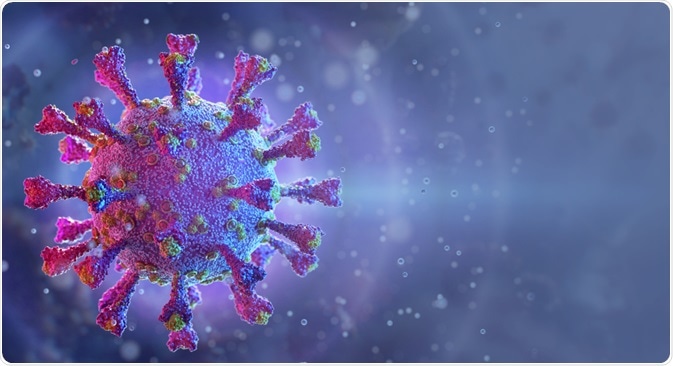Some of the recent advancements in the cell biology field that will be discussed in this article include possible new treatments for Sickle Cell Disease and COVID-19. These therapies use advanced methods in molecular biology such as the CRISPR-Cas9 system, stem cell treatment, and nanoparticles; all of which target specific dysfunctional cells within the body.

COVID-19 Virus. Image Credit: Corona Borealis Studio/Shutterstock.com
Using CRISPR-Cas9 gene editing for Sickle Cell Disease and Beta Thalassemia
One of the recent advancements in cell biology is using CRISPR-cas9 gene-editing methods to improve the effects of specific blood disorders. Sickle Cell Disease and Beta Thalassemia are some of the most common genetic diseases in the world, with approximately 300,000 and 60,000 patients diagnosed annually. Both of these diseases are caused by mutations in the hemoglobin beta-subunit gene.
More specifically, Beta Thalassemia is caused by ineffective erythropoiesis as a result of irregularities in globin. On the other hand, sickle cell is caused by a point mutation in amino acid 6, where valine replaces glutamic acid in the hemoglobin subunit beta gene.
Knocking down the BCL11A gene has previously shown evidence of reactivating the gamma-globin gene, thus potentially having therapeutic effects in sickle cell disease. A recent study, therefore, used the CRISPR-cas9 system to target BCL11A in 2 patients with sickle cell and beta-thalassemia. The results of this study demonstrated an increase in fetal hemoglobin expression and eliminated the need for blood transfusions and vaso-occlusive episodes in the two patients.
This trial, therefore, provided some evidence supporting the use of CRISPR-cas9 gene editing systems to treat various genetic diseases that affect the biological structure and function of red blood cells.
Using Mesenchymal stem cells to treat COVID-19 induced acute respiratory distress syndrome patients
Since the coronavirus pandemic arose in November 2019, there have been a total of approximately 124 million cases and 2.73 million deaths worldwide. Thus, it is no surprise that the pandemic has brought on several clinical trials in hopes of creating treatments, such as a viable vaccine, to protect against the virus. Many clinical trials are aiming to reduce some fatal side effects of the virus, and the results of these studies are some of the more recent advancements in cell biology.
Acute respiratory distress syndrome (ARDS) is one of the complications of the coronavirus-19 disease (COVID-19). Symptoms of ARDS include severe shortness of breath, feeling faint, tiredness, and rapid breathing. To tackle this problem, a recent study in January 2021 used human mesenchymal stem cells, in a phase 1 clinical trial, as a potential therapeutic for ARDS in critically ill COVID-19 patients.
11 critically ill patients requiring mechanical ventilation took part in the trial, and they were administered three intravenous infusions of mesenchymal stem cells every other day. The findings suggested that multiple infusions of prenatal mesenchymal stem cells have the potential to quickly improve symptoms of ARDs and reduce inflammation in critically ill COVID-19 patients.
While the results and outlooks are looking positive; it is clear that further studies using mesenchymal stem cell therapy using a larger cohort group is necessary, to thoroughly evaluate the safety and efficacy of the newly emerging treatment.
Using nanoparticle DNAse-1 to suppress COVID-19-mediated neutrophil activities
The final advancement in cell biology that will be discussed in this article is also concerning COVID-19. Namely, it is using nanoparticles against COVID-19 in hopes of preventing potentially fatal immune responses. To explain, a recent study intravenously used DNAse-1 as a nanoparticle to inhibit the effects of NETosis, a process that can worsen the effects of COVID-19, to reduce sepsis and improve survival.
The findings of the study suggested that reducing cfDNA, a NETosis factor could be a potential therapeutic for patients with COVID-19-infected sepsis; using long-acting DNAse-1 nanoparticles. Furthermore, it also shows that DNAse-1 could be a potential new therapeutic option for sepsis in general, not just in patients with COVID-19.
Overall, however, the trial has shown some evidence to suggest that NETosis markers can be a therapeutic target in COVID-19 patients. These recent advancements also open up the possibility of conducting further trials to develop treatment options for those severely affected by COVID-19.
Sources:
- Frangoul, H., Altshuler, D., Cappellini, M., Chen, Y., Domm, J., Eustace, B., Foell, J., de la Fuente, J., Grupp, S., Handgretinger, R., Ho, T., Kattamis, A., Kernytsky, A., Lekstrom-Himes, J., Li, A., Locatelli, F., Mapara, M., de Montalembert, M., Rondelli, D., Sharma, A., Sheth, S., Soni, S., Steinberg, M., Wall, D., Yen, A. and Corbacioglu, S., 2021. CRISPR-Cas9 Gene Editing for Sickle Cell Disease and β-Thalassemia. New England Journal of Medicine, 384(3), pp.252-260.
- Hashemian, S., Aliannejad, R., Zarrabi, M., Soleimani, M., Vosough, M., Hosseini, S., Hossieni, H., Keshel, S., Naderpour, Z., Hajizadeh-Saffar, E., Shajareh, E., Jamaati, H., Soufi-Zomorrod, M., Khavandgar, N., Alemi, H., Karimi, A., Pak, N., Rouzbahani, N., Nouri, M., Sorouri, M., Kashani, L., Madani, H., Aghdami, N., Vasei, M. and Baharvand, H., 2021. Mesenchymal stem cells derived from perinatal tissues for treatment of critically ill COVID-19-induced ARDS patients: a case series. Stem Cell Research & Therapy, 12(1).
- Lee, Y., Park, H., Park, W., Kim, H., Jang, J., Hong, K., Lee, J., Seo, H., Na, D., Kim, T., Choy, Y., Ahn, J., Lee, W. and Park, C., 2021. Long-acting nanoparticulate DNase-1 for effective suppression of SARS-CoV-2-mediated neutrophil activities and cytokine storm. Biomaterials, 267, p.120389.
Further Reading
Last Updated: Apr 29, 2021